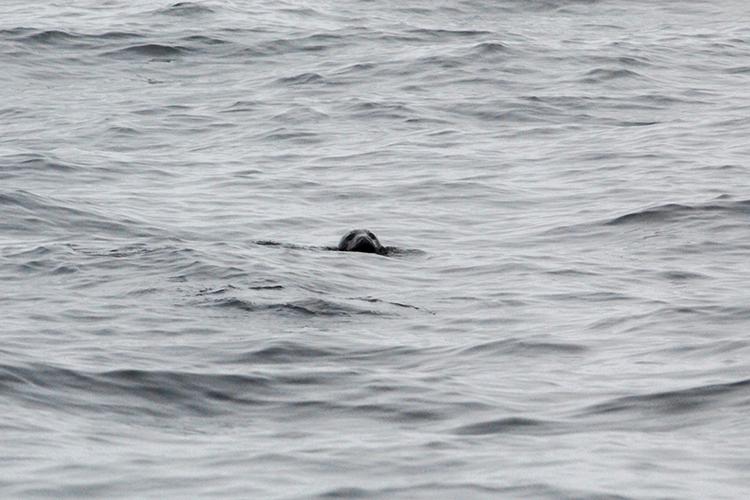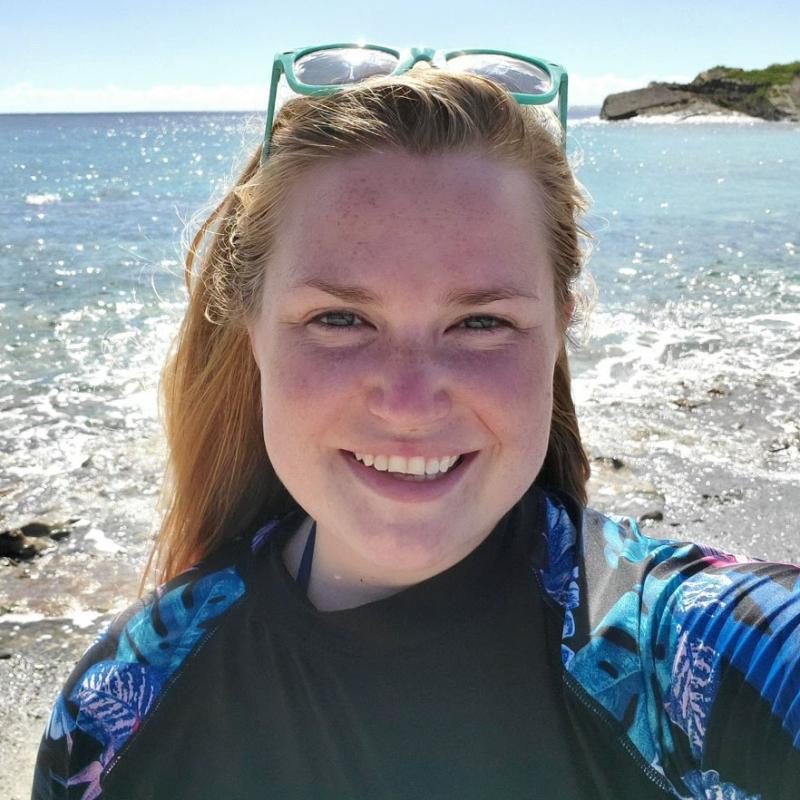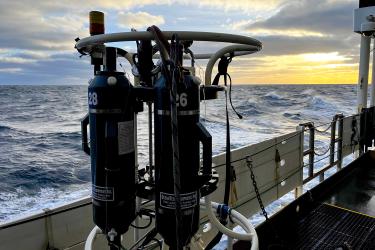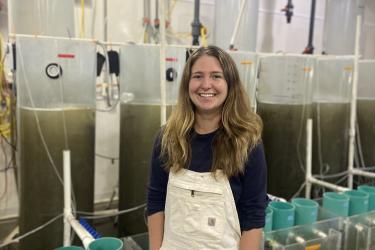The 2023 Spring Gulf of Maine Bottom Longline Survey was off to a bit of a gloomy start. It was a fairly foggy and drizzly day when we sailed out of Sandwich, Massachusetts on the F/V Tenacious II. As we rounded Race Point at the very tip of Cape Cod, the fog lifted just enough to try to take photos of some murres—black and white seabirds that vaguely resemble small penguins. That’s when I spotted a whale tail plunge into the water! It’s been my quest since joining the longline team to see and photograph some whales. I feel like I’m the only one who hadn’t seen them on the survey yet. Unfortunately I wasn’t quick enough for either the whale or the birds. I did manage to snap a photo of a curious gray seal scoping us out as we glided on by in the haze during transit. I know some commercial and recreational fishermen would disagree with me, but I never tire of seeing seals.
We sampled at two locations near Race Point, which were pretty uneventful and light on catch. Then we said goodbye to the fog and headed east toward the Hague Line—the international boundary that divides U.S. and Canadian waters on Georges Bank. It’s way out in the middle of nowhere. Much to my delight, we briefly found ourselves with a hitchhiker. It’s not uncommon to see landbirds like this Savannah sparrow hitch a ride on fishing vessels. Landbirds sometimes get blown off course and out to sea, and they find refuge on passing boats. While I left out some fresh water and crumbs in the hopes it would stay with us until we got back to land, it flew away unnoticed. Perhaps it found another vessel to rest on while continuing its journey back to land.
Out east, our catches were slightly more varied, but still rather light. Most of the catch was Atlantic spiny dogfish and red hake, with smatterings of haddock, Atlantic cod, and white hake mixed in. We had almost an entire basket of blackbelly rosefish and Acadian redfish in one haul. That was something a bit fun and different! Blackbelly rosefish look different from Acadian redfish. They have a black mouth on the inside and tend to have more variation in color on the outside with lots of darker speckling all over. They continue this patterning up toward the eyes, reminding me of the spots on frogs. Acadian redfish are a much more uniform orangey-red color, and all of them had bulging eyes caused by the barotrauma of coming up from depth.
Interesting tidbit: Whereas most fish lay eggs, Acadian redfish give birth to live young. Both fish are part of the larger Scorpaenidae family, a group that includes some venomous fish, like lionfish. These two fish species aren’t that dangerous, but they both have very sharp spines on their dorsal fins so everybody handled them gingerly.
Another thing we sometimes “catch” are sea pens. These invertebrates resemble old-fashioned writing quills, hence the name. During one haul we accidentally caught a few. The vessel mate kindly lined them up all nice in a row for us. Sea pens are a type of octocoral, a colony of individual polyps with eight hollow tentacles. The primary polyp loses these tentacles to form the stalk, which anchors the sea pen to the seafloor. Unlike shallow-water corals that have symbiotic algae to help photosynthesize food, these deepwater organisms have adapted to use their secondary polyps—the feathery branches—to filter food particles from the water.
On the last haul we also caught some fairly large barndoor skates—presumably named because they appear as large as a barn door. While that’s a bit exaggerated, they do get quite large, up to 5 feet long and 40 pounds. When they’re that big, they can be difficult to handle and put into a basket to weigh.
Probably the catch highlight of the trip, which was truly unexpected, was a spoonarm octopus. It has been Captain Eric Hesse’s wish to get an octopus on the survey. His wish came true during our fall 2022 survey. That octopus had been coughed up by a white hake on the hook. This time, it was the octopus itself that was on the hook. You can almost hear Eric in this picture saying “What are the chances we’d get another one?!”
The octopus was very much still alive, and I had a hard time getting it back into the water because it kept gripping my glove. I tried so hard to get it overboard away from the seagulls, but I yelled when I lost sight of it and then saw the birds tearing at something near where it went overboard. I breathed a sigh of relief when I saw they were trying to swallow a red hake instead of the octopus. I’m not entirely sure what became of it, but I choose to believe it made it safely back to the seafloor. It’s rare occurrences like this that make me excited to go out on the next trip to see what we get next!








